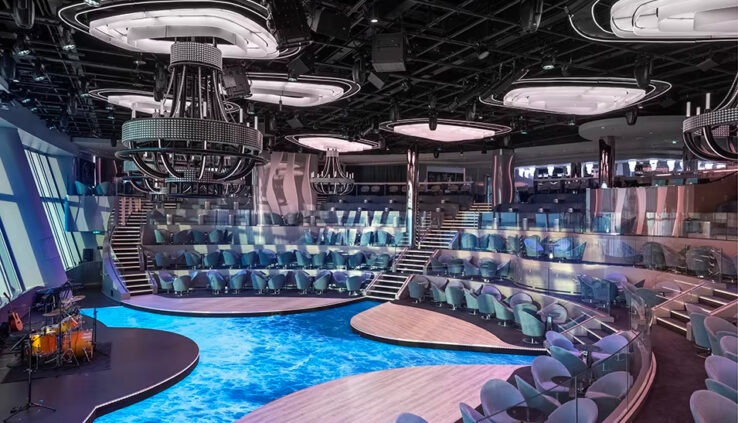MSC Streamlines Its Cruise Ships’ Large AV Infrastructure with NDI
By Jennifer P
MSC Cruises, one of the world’s top cruise lines with a remarkable 300-year history of maritime exploration, has undertaken a groundbreaking initiative to transform the audio-visual (AV) infrastructure on their cruise ships using NDI technology. In the past, MSC, like many others in the industry, relied on traditional HDMI and SDI cables to interconnect video equipment throughout their ships. This approach presented a multitude of challenges, ranging from the unwieldy size of the equipment and high costs to the limited interoperability of their AV systems. The sheer volume of video flows, roughly 200 on a single ship, created a cumbersome and intricate network that was reminiscent of a high-capacity network studio such as those operated by NBC Universal or Time Warner.
Moreover, operating at sea posed unique and complicated challenges that differed significantly from working in a traditional studio environment. SDI cables, once installed, were challenging to replace, making adaptability a key concern. The AV teams had to meticulously plan and bring all necessary equipment on board, including redundant systems and devices for every potential contingency. For example, if they lacked a frame converter and a situation required one, their options were limited.
In pursuit of a more efficient, adaptable, and lightweight infrastructure, André Nunes, MSC’s Manager of Digital Video and Broadcasting, made the bold decision to transition to an NDI-based infrastructure for the MSC Explora and MSC Europa cruise lines. The primary motivations behind this shift were to reduce infrastructure bulk, save valuable space, and enhance interconnectivity through the use of advanced fiber optic lines. André Nunes expressed his confidence in this decision, stating, “I believe we have the biggest infrastructure in the world aboard the MSC Europa, and I’m not joking. The decision to go with NDI was largely about reducing infrastructure, saving space, and supporting interconnectivity through fiber optic lines.”
Implementing a new AV infrastructure on this scale is no easy task, especially in the middle of the open sea. To make this ambitious vision a reality, André and his team sought the expertise of Hewlett Packard Enterprise (HPE) to design and deploy the NDI infrastructure. In addition to HPE, MSC also partnered with AdCom to orchestrate and fine-tune the setup right from the project’s conception. Their services included organizing routings, closing domains, and designing workflows, all critical aspects of this large-scale AV transformation. Collaborating with these consultants was essential in overcoming the latency challenges caused by the strict firewalls mandated on all MSC cruise ships.
Together, with the support of their trusted consultants, André and his team succeeded in constructing a comprehensive NDI infrastructure, which included an array of components such as 133 Kiloview Devices (encoders and decoders), 24 Panasonic PTZ Cameras, 6 Vizrt Tricasters, and a Sienna Router featuring a 160×160 crosspoint matrix. The system handled more than 200 total NDI streams, all skillfully managed by HPE Network Switches running on fiber optic cables. This architecture featured link aggregation between AS and DS at 40 GB, with 200 GB directly on the core network, ensuring redundancy and reliability.
One of the most significant outcomes of this innovative transformation is that, thanks to the NDI-based infrastructure, André and his team have established a highly functional network that is perfectly suited for sailing the seven seas. The MSC Explora and MSC Europa cruise lines now enjoy several key advantages, including:
- Minimal, streamlined infrastructure: The adoption of NDI technology has significantly reduced the size and bulk of AV equipment, making the ship’s operations more efficient.
- Flexible, interoperable equipment: NDI’s capabilities have enhanced the interconnectivity and adaptability of the AV equipment, allowing for seamless operation and communication between various devices.
- Reduced costs per connection: Not only has the adoption of NDI streamlined the infrastructure, but it has also led to cost savings in terms of equipment procurement, installation, and maintenance.
Achieving this impressive feat required close collaboration with HPE and AdCom’s consultants, who played a crucial role in navigating the complex challenges associated with firewalls and access controls. Their expertise and guidance ensured that MSC Cruises had the right equipment to overcome these challenges and establish a highly functional multicast network.
In summary, MSC Cruises’ transition to NDI technology has marked a significant milestone in the cruise industry, setting new standards for AV infrastructure on their cruise ships. By embracing this forward-thinking approach, they have not only enhanced the quality and flexibility of their AV systems but have also made substantial improvements in cost-efficiency and infrastructure management, ultimately ensuring a top-notch experience for passengers aboard the MSC Explora and MSC Europa cruise lines.
Read the full case study from NDI HERE
Learn more about NDI HERE
Learn more about Panasonic PTZ Cameras HERE
Learn more about Vizrt TriCasters HERE

